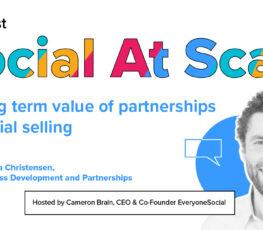Most B2B marketing professionals are aware that inbound marketing is a proven strategy for lead generation. It is easy to understand why. The Internet has shifted the power to access information from a supplier-controlled situation to a buyer-controlled one. Still, many companies fail to capitalize on their greatest potential inbound marketing resource – their own sales force.
After all, in this age of social networks, each salesperson has an audience (i.e. LinkedIn Connections or Twitter Followers) and a platform for publishing content to them.
3 Reasons Why Salespeople Are a Great Content Sharing Resource:
1. Big Audience Reach
One of my clients had a LinkedIn company page that managed to attract 13,671 Followers over the past three years. Marketing was stoked. The company also had 300 salespeople. A few months after social selling training, they averaged 527 LinkedIn connections each. Do the math.
That’s a combined audience of over 150,000 people – 11 times larger than the audience that marketing had amassed on the Linkedin company page… in 3 years.
The main reason any company has a sales force in the first place is to extend coverage. Why shouldn’t this same “extend coverage” reason apply to a social content sharing strategy?
2. A Blend of Content Types
Salespeople are in a unique position to share a blend of content types including:
- Company-supplied content
- Third-party industry content
- Original content
Content from the company’s marketing department is the foundation of a corporate social content strategy. It’s been vetted, professionally created, and is aligned with the company strategy. It’s also easy to come by since it is usually the same information that the company’s social media team is posting on the company blog and social accounts.
One client told me that social shares by the sales team have become the number one source of webinar registrations.
Sharing industry content positions salespeople as being in-tune with market trends. It can often be more timely and locally-focused than content from Marketing, which might have created the editorial calendar six months prior.
One business insurance client in North Carolina received a huge number of Likes and Comments after he posted an article on how to avoid frozen pipes just days before single-digits temperatures hit the Carolinas. Finally, salespeople can leverage their unique experiences to create original content.
Some may scoff at the idea of salespeople creating original content, but I am not advocating that every salesperson become a blogger. One of my clients is the country’s largest supplier of commercial roofing.
One salesperson had the brilliant idea to start sharing field photos of roof problems (leaks, poor flashing, improper installations) along with his expert recommendations for repair and avoidance.
Customer response to these authentic updates has raised visibility, credibility, and driven inbound inquires through the roof (I couldn’t stop myself).
3. Genuine Relationships
At a conference last year, a speaker shared a statistic from a recent Digital Marketing report that stating 68% of CMOs planned to invest in resources to deliver more personalized communications. My first reaction was, “Doesn’t every company already have it? Personalized communications is what good salespeople do every day.”
Salespeople have the most experience communicating with customers. That’s basically their entire job description. Many people overlook the fact that social networks like LinkedIn and Twitter have multiple methods for sharing content.
The best known is the network-wide share (“Updates” for LinkedIn and “Tweets” for Twitter), but each also has a method for 1:1 messaging (“Send to Individuals” for LinkedIn and “Direct Message” for Twitter).
This gives salespeople the power to broadcast and narrowcast the same content in one fell swoop. Imagine a cloud security salesperson sees an article on CIO.com about new ways to protect networks.
She could broadcast it to be a value to her entire network and send it directly to a customer connection with a note, “Here’s the latest information on the security issues we discussed last week.”
Companies that enjoy the greatest gains from social networks are the ones that devise an aligned Sales and Marketing strategy and then carry it out through the deployment of the proper tools and training.
Kurt Shaver speaks about and trains corporate sales teams on advanced Social Selling skills. He has appeared at conferences like Sales 2.0, AA-ISP Social Selling, and LinkedIn’s Sales Connect. Clients include leading companies in the technology, telecom, insurance, and business services industries.
Learn more at The Sales Foundry. Connect with Kurt on LinkedIn or follow him on Twitter
Learn how a social selling program can amplify your lead generation. Schedule your personal demo of EveryoneSocial.
![]()















